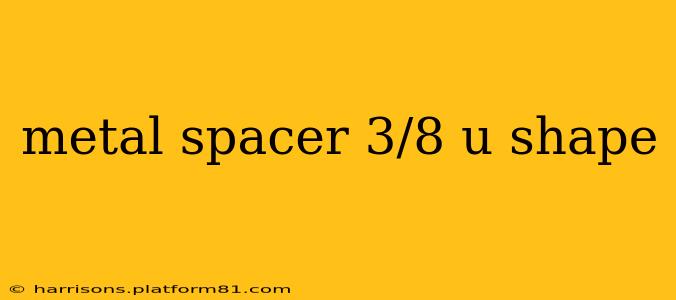Finding the right metal spacer can be tricky, especially when you need a specific size and shape like a 3/8" U-shaped one. This guide will walk you through everything you need to know to find the perfect fit for your project, covering materials, applications, and where to source them.
What are Metal Spacers?
Metal spacers are mechanical components used to maintain a precise distance between two or more parts. They come in various shapes, sizes, and materials, each suited for different applications. Their primary function is to prevent parts from rubbing against each other, providing insulation, or enhancing structural integrity. U-shaped spacers, in particular, are often used where one part needs to be raised or supported above another, creating a gap.
Why Choose a 3/8" U-Shaped Metal Spacer?
The dimensions of a spacer—in this case, 3/8" referring likely to the leg length of the U-shape—are crucial. A 3/8" U-shaped spacer is ideal for applications requiring a relatively small, yet defined, separation between components. The U-shape offers added stability compared to other spacer types, as it provides support on both sides. The specific application will dictate the material choice.
What Materials are Commonly Used for 3/8" U-Shaped Metal Spacers?
The material of your spacer depends on the application and required properties. Common materials include:
- Aluminum: Lightweight, corrosion-resistant, and easily machinable. A good choice for many general applications.
- Stainless Steel: Excellent corrosion resistance and high strength, ideal for outdoor or harsh environments.
- Brass: Good corrosion resistance and machinability, often chosen for its aesthetic appeal.
- Steel: High strength and durability, but susceptible to corrosion without proper treatment.
Choosing the right material ensures your spacer can withstand the intended stresses and environmental conditions.
Where Can I Find a 3/8" U-Shaped Metal Spacer?
Sourcing these specialized components can involve several avenues:
- Online Retailers: Websites like Amazon, McMaster-Carr, and specialized fastener suppliers often carry a wide variety of spacers. Precise searches using keywords like "3/8 inch U-shaped spacer," along with the material (e.g., "aluminum 3/8 inch U-shaped spacer"), will yield the best results.
- Local Hardware Stores: While selection might be more limited, local hardware stores can be a quick and convenient source for common spacer types.
- Industrial Suppliers: For large-scale projects or specialized requirements, contacting industrial suppliers who cater to manufacturing and engineering needs is recommended.
- Custom Manufacturing: If you need a highly specific spacer or have unique requirements, exploring custom manufacturing options is possible, although this will likely be more expensive.
What are the Different Types of Metal Spacers?
While focusing on U-shaped spacers, it's helpful to understand other types available:
- Standoffs: These cylindrical spacers maintain distance between parallel surfaces.
- Washers: While primarily used for securing fasteners, some washers can act as thin spacers.
- Bushings: These cylindrical spacers are typically used for alignment and reducing friction between rotating parts.
What are the Key Specifications to Consider When Buying a Metal Spacer?
Beyond the overall dimensions, consider these specifications:
- Material: As discussed above, choose the material based on your application's requirements.
- Inner and Outer Dimensions (for U-shaped): Ensure the inner and outer dimensions of the U-shape accommodate your parts correctly.
- Wall Thickness: The thickness of the spacer's legs impacts strength and rigidity.
- Tolerance: The allowable variation in dimensions is crucial for precision applications.
This guide provides a thorough overview of finding the right 3/8" U-shaped metal spacer. Remember to carefully consider the specifications and material to ensure compatibility with your project. By understanding the nuances of spacer types and sourcing options, you can successfully integrate this critical component into your design.
